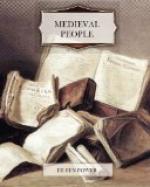67. Ibid., p. xlix.
68. Ibid., App. I., pp. xlix-lii, a very interesting note on contemporary coinage, identifying all the coins mentioned in the letters.
69. Ibid., p. 159.
70. Ibid., p. 161.
71. Stonor Letters, II, p. 43. So Dame Elizabeth Stonor ends a letter to her husband: ’Written at Stonor, when I would fain have slept, the morrow after our Lady day in the morning,’—Ibid., p. 77.
72. Chaucer, Canterbury Tales (Shipman’s Tale), LL, 1265-78, in Works (Globe Ed., 1903), p. 80.
73. The will is P.C.C. 24 Logge at Somerset House. For this analysis of its contents and information about the life of Thomas Betson after his breach with the Stonors see Stonor Letters, I, pp. xxviii-ix.
74. They are (1) John Bacon, citizen and woolman, and Joan, his wife (d. 1437); (2) Thomas Gilbert, citizen and draper of London and merchant of the Staple of Calais (d. 1483), and Agnes, his wife (d. 1489); (3) Christopher Rawson, mercer of London and merchant of the Staple of Calais, Junior Warden of the Mercers’ Company in 1516 (d. 1518), and his two wives. Thomas Betson was doubtless acquainted with Gilbert and Rawson.
CHAPTER VII
THOMAS PAYCOCKE OF COGGESHALL
A. Raw Material
1. The raw material for this chapter consists of Paycocke’s House, presented to the Nation in 1924 by the Right Hon. Noel Buxton, M.P., which stands in West Street, Coggeshall, Essex (station, Kelvedon); the Paycocke brasses, which lie in the North aisle of the parish church of St Peter ad Vincula at Coggeshall; and the wills of John Paycocke (d. 1505), Thomas Paycocke (d. 1518), and Thomas Paycocke (d. 1580), which are now preserved at Somerset House (P.C.C. Adeane 5, Ayloffe 14, and Arundell 50, respectively), and of which that of the first Thomas has been printed in Mr Beaumont’s paper, cited below, while I have analysed fully the other two in my book, The Paycockes of Coggeshall (1920), which deals at length with the history of the Paycockes and their house. See also G.F. Beaumont, Paycocke’s House, Coggeshall, with some Notes on the Families of Paycocke and Buxton (reprinted from Trans. Essex Archaeol. Soc., IX, pt. V) and the same author’s History of Coggeshall (1890). There is a beautifully illustrated article on the house in Country Life (June 30, 1923), vol. LIII, pp. 920-6.
2. For an apotheosis of the clothiers, see The Pleasant History of John Winchcomb, in his younger days called Jack of Newbery, the famous and worthy Clothier of England and Thomas of Reading, or the Six Worthy Yeomen of the West, in The Works of Thomas Deloney, ed. F.O. Mann (1912), nos. II and V. The first of these was published in 1597 and the other soon afterwards and both went through several editions by 1600.




